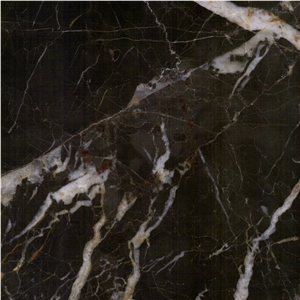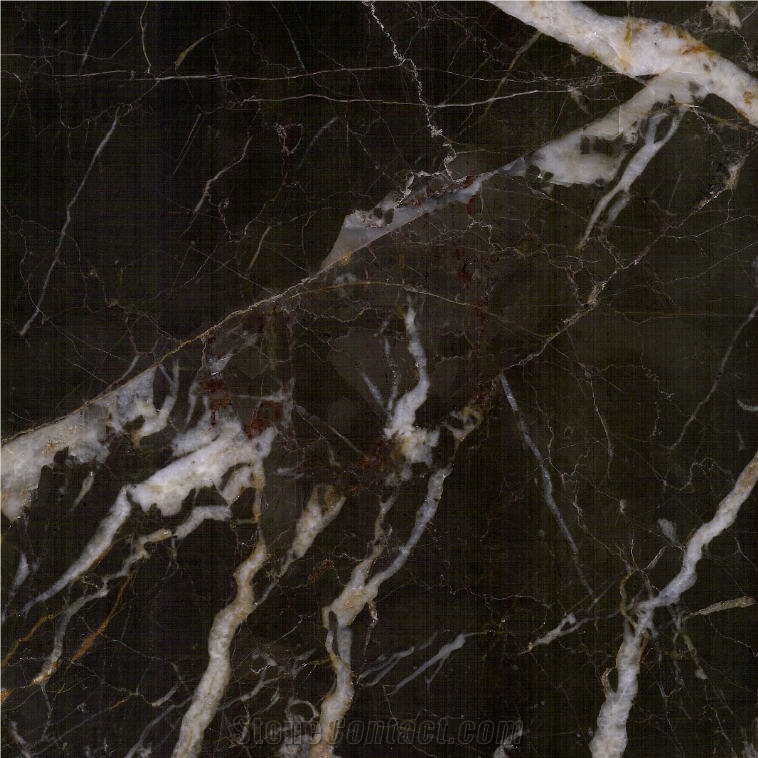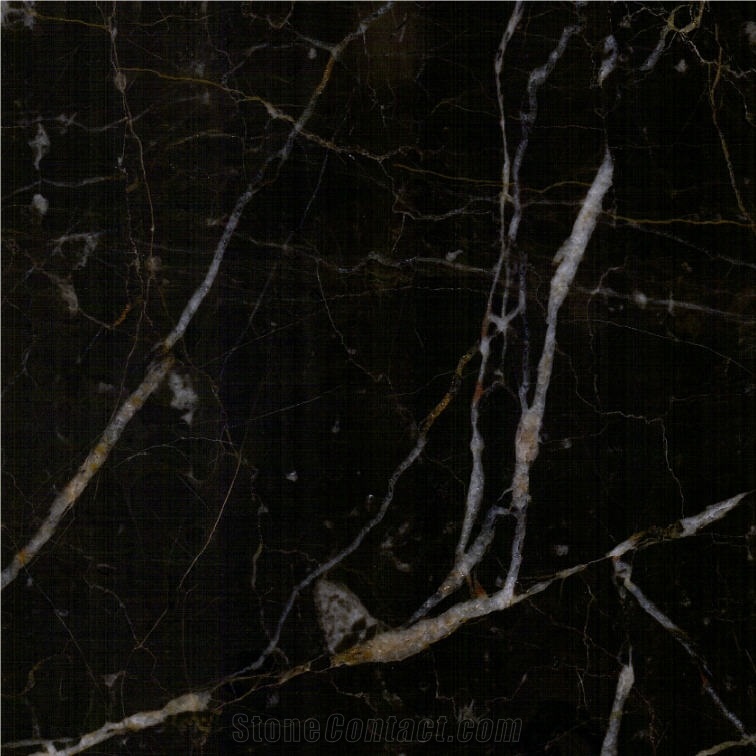Noir St. Laurent Marble
 Morocco
(Biougra, Agadir, Sud Morocco)
Morocco
(Biougra, Agadir, Sud Morocco)
Noir St. Laurent Marble is an opulent and captivating natural stone quarried in Biougra, Agadir, Sud Morocco. This marble is renowned for its rich black background, which serves as a luxurious canvas for the prominent streaks of gold and white veins that traverse its surface.
The predominant color of Noir St. Laurent Marble is a deep and velvety black, creating a sense of sophistication and elegance. The gold and white veins add a striking contrast, introducing a dynamic and visually appealing element to the stone. The interplay of these contrasting colors forms intricate patterns, enhancing the marble's overall aesthetic.
The luxurious appearance of Noir St. Laurent Marble, with its gold and white veining against the dark backdrop, makes it a sought-after choice for high-end interior applications. Common uses include flooring, wall cladding, countertops, and other decorative elements where the dramatic veining can serve as a focal point.
The origin of this marble from Biougra, Agadir, Sud Morocco adds to its allure, as stones from specific regions often carry unique characteristics. Noir St. Laurent Marble's combination of rich black tones and vibrant veins makes it a timeless and elegant option for those seeking to incorporate a touch of luxury into their architectural and design projects.

What are the different types of Noir St. Laurent Marble columns?

Does black Noir St. Laurent Marble scratch easily?

What is the average density of Morocco's Noir St. Laurent Marble?

Why not to use Noir St. Laurent Marble in shower?

Is Morocco's Noir St. Laurent Marble an expensive stone?

With which machines are Noir St. Laurent Marble columns made?

What should be done to protect Noir St. Laurent Marble columns from humidity and mold?

Is Noir St. Laurent Marble good for hot weather?

Can Morocco's Noir St. Laurent Marble be used outdoors?

Is quartz better than Noir St. Laurent Marble for vanity top?

Why is Noir St. Laurent Marble not good for bathrooms?

What are the standard dimensions of Noir St. Laurent Marble balusters?

Is honed surface Noir St. Laurent Marble slippery when wet?

Is black Noir St. Laurent Marble good for bathroom renovation?

How can I clean the grout lines of Noir St. Laurent Marble mosaics?

How can I install Noir St. Laurent Marble floor medallions?

Does vinegar scratch Noir St. Laurent Marble countertop?

Is Noir St. Laurent Marble tile good for bathroom floors?

How should Noir St. Laurent Marble columns be packaged to prevent scratching during transportation?

What is the thickness of Noir St. Laurent Marble for stairs?

Is Noir St. Laurent Marble good for dining table top?

Are there color variations of Morocco's Noir St. Laurent Marble?

How can I maintain the surface of scratched Noir St. Laurent Marble table tops?

How long does it take to carve a Noir St. Laurent Marble bust with CNC machine?

What grade is Morocco's Noir St. Laurent Marble?

Is a black Noir St. Laurent Marble shower floor a good idea?

What is the best tool to cut Noir St. Laurent Marble tiles?

Can I cut Noir St. Laurent Marble tiles with a grinder?

Can Morocco's Noir St. Laurent Marble be used in a living room?

Why do we need water to cut Noir St. Laurent Marble?

Can Morocco's Noir St. Laurent Marble be used in landscaping?

What type of adhesive should be used when applying Noir St. Laurent Marble mosaics to the floor and walls?

How can I clean Noir St. Laurent Marble stairs?

How much weight can Noir St. Laurent Marble table tops carry at maximum?

What is the coefficient of friction of Leathered Morocco's Noir St. Laurent Marble tiles?

Can I use Noir St. Laurent Marble mosaic on a floor?

Is a black Noir St. Laurent Marble vanity top a good idea?

What are the disadvantages of Noir St. Laurent Marble flooring?

What is the standard Noir St. Laurent Marble table top thickness?

Is Noir St. Laurent Marble table high maintenance?

Does Noir St. Laurent Marble crack in sunlight?

Is black Noir St. Laurent Marble hard to maintain?

What are the parts of a Noir St. Laurent Marble column?

Can I cut Noir St. Laurent Marble with a tile cutter?

How thick is Morocco's Noir St. Laurent Marble slabs?

How can Noir St. Laurent Marble table tops be supported to prevent breakage?

Does Noir St. Laurent Marble floor crack easily?

Can Morocco's Noir St. Laurent Marble be used exterior applications in very sunny climates?

Can Noir St. Laurent Marble be used as shower base?

What is the disadvantage of Noir St. Laurent Marble in shower?
-

 Turkey
Turkey
 3YRDiamond members are premium members on platform, providing members with comprehensive approach to promoting their products, increasing products exposure and investment return to maximize.
3YRDiamond members are premium members on platform, providing members with comprehensive approach to promoting their products, increasing products exposure and investment return to maximize.
 Verified Supplier is for prove company authenticity,including business license,trade license and effective office space,to enhance buyers' trust to suppliers and their products, reducing communication costs.
Verified Supplier is for prove company authenticity,including business license,trade license and effective office space,to enhance buyers' trust to suppliers and their products, reducing communication costs.
Contact Supplier
-

 Morocco
Morocco
 11YRDiamond members are premium members on platform, providing members with comprehensive approach to promoting their products, increasing products exposure and investment return to maximize.
11YRDiamond members are premium members on platform, providing members with comprehensive approach to promoting their products, increasing products exposure and investment return to maximize.
 Verified Supplier is for prove company authenticity,including business license,trade license and effective office space,to enhance buyers' trust to suppliers and their products, reducing communication costs.
Verified Supplier is for prove company authenticity,including business license,trade license and effective office space,to enhance buyers' trust to suppliers and their products, reducing communication costs.
Contact Supplier
-

 Morocco
Morocco
 11YRDiamond members are premium members on platform, providing members with comprehensive approach to promoting their products, increasing products exposure and investment return to maximize.
11YRDiamond members are premium members on platform, providing members with comprehensive approach to promoting their products, increasing products exposure and investment return to maximize.
 Verified Supplier is for prove company authenticity,including business license,trade license and effective office space,to enhance buyers' trust to suppliers and their products, reducing communication costs.
Verified Supplier is for prove company authenticity,including business license,trade license and effective office space,to enhance buyers' trust to suppliers and their products, reducing communication costs.
Contact Supplier
-

 China
China
 15YRDiamond members are premium members on platform, providing members with comprehensive approach to promoting their products, increasing products exposure and investment return to maximize.
15YRDiamond members are premium members on platform, providing members with comprehensive approach to promoting their products, increasing products exposure and investment return to maximize.
 Verified Supplier is for prove company authenticity,including business license,trade license and effective office space,to enhance buyers' trust to suppliers and their products, reducing communication costs.
Verified Supplier is for prove company authenticity,including business license,trade license and effective office space,to enhance buyers' trust to suppliers and their products, reducing communication costs.
Contact Supplier
-

 Morocco
Morocco
 11YRDiamond members are premium members on platform, providing members with comprehensive approach to promoting their products, increasing products exposure and investment return to maximize.
11YRDiamond members are premium members on platform, providing members with comprehensive approach to promoting their products, increasing products exposure and investment return to maximize.
 Verified Supplier is for prove company authenticity,including business license,trade license and effective office space,to enhance buyers' trust to suppliers and their products, reducing communication costs.
Verified Supplier is for prove company authenticity,including business license,trade license and effective office space,to enhance buyers' trust to suppliers and their products, reducing communication costs.
Contact Supplier
-

XIAMEN TOP STARS STONE COMPANY LIMITED
 China
China
 10YRDiamond members are premium members on platform, providing members with comprehensive approach to promoting their products, increasing products exposure and investment return to maximize.
10YRDiamond members are premium members on platform, providing members with comprehensive approach to promoting their products, increasing products exposure and investment return to maximize.
 Verified Supplier is for prove company authenticity,including business license,trade license and effective office space,to enhance buyers' trust to suppliers and their products, reducing communication costs.
Verified Supplier is for prove company authenticity,including business license,trade license and effective office space,to enhance buyers' trust to suppliers and their products, reducing communication costs.
Contact Supplier
-

 Italy
Italy
Contact Supplier
-

 China
China
 Verified Supplier is for prove company authenticity,including business license,trade license and effective office space,to enhance buyers' trust to suppliers and their products, reducing communication costs.
Verified Supplier is for prove company authenticity,including business license,trade license and effective office space,to enhance buyers' trust to suppliers and their products, reducing communication costs.
Contact Supplier
-

-

Xiamen MayCo Stone Industry Co., Ltd.
 China
China
 7YRDiamond members are premium members on platform, providing members with comprehensive approach to promoting their products, increasing products exposure and investment return to maximize.
7YRDiamond members are premium members on platform, providing members with comprehensive approach to promoting their products, increasing products exposure and investment return to maximize.
 Verified Supplier is for prove company authenticity,including business license,trade license and effective office space,to enhance buyers' trust to suppliers and their products, reducing communication costs.
Verified Supplier is for prove company authenticity,including business license,trade license and effective office space,to enhance buyers' trust to suppliers and their products, reducing communication costs.
Contact Supplier
The request includes: 1. surface finished, size 2. quantity required









